
Poland facts and history
in brief
Pope John Paul II
Excerpted from Wikipedia, the free encyclopedia
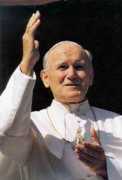 |
Name: Karol Józef Wojtyla
Papacy began: October 16, 1978
Papacy ended: April 2, 2005
Predecessor: John Paul I
Successor: Benedict XVI
Born: May 18, 1920
Place of birth: Wadowice, Poland
Died: April 2, 2005
Place of death: Apostolic Palace, Vatican City
|
John Paul II
Excerpted from Wikipedia, the free encyclopedia
The Servant of God Pope John Paul II (Latin: Ioannes
Paulus PP. II), born Karol Józef Wojtyla (May
18, 1920 – April 2, 2005), reigned as pope of the
Roman Catholic Church and sovereign of Vatican City
and of the Holy See for almost 27 years, from 16 October
1978 until his death in 2005. He is often referred to
as Pope John Paul the Great. On 13 May 2005 Pope Benedict
XVI, John Paul II's successor, waived the five year
waiting period for a cause for beatification to be opened.
The official process for beatification began in the
Diocese of Rome on June 28, 2005.
The first non-Italian to serve in office since the Dutch-German
Pope Adrian VI died in 1523, John Paul II's reign was
the third-longest in the history of the Papacy, after
those of Saint Peter (approximately 35 years) and Blessed
Pius IX (31 years). This is in a distinctive contrast
with that of his predecessor Pope John Paul I, who died
suddenly after only 33 days in office, and in whose
memory John Paul II named himself.
Pope John Paul II's reign was marked by a continuing
decline of Catholicism in developed countries but expansion
in the Third World. In addition, John Paul II advocated
conservative values in the Roman Catholic Church, opposing
gay marriage and abortion, among a host of other issues;
however, the Pontiff voiced support for the theory of
evolution. During his reign, the pope travelled extensively,
visiting over 100 countries and all continents except
Antarctica. His health deteriorated in the late 1990s,
as he was diagnosed with Parkinson's Disease. On 2 April
2005, two months after receiving a tracheotomy, Pope
John Paul II passed away.

Overview
The man from Poland will be remembered as the
"people's Pope." He is respected around the
world by both Christians and non-Christians. There is
a John Paul II Foundation which has many offices around
the world. The headquarters is located in Rome in the
Polish House.
His papacy is remembered by his tireless ecumenical
approach to accommodate other Christian sects as well
as to forge a better understanding with the Islamic
world. At his funeral, many non-Christian faiths were
represented, including representatives from Islam and
Buddhism.
John Paul II emphasized what he called the "universal
call to holiness" and attempted to define the Catholic
Church's role in the modern world. He spoke out against
ideologies and politics of communism, feminism, imperialism,
relativism, materialism, fascism (including nazism),
racism and unrestrained capitalism. In many ways, he
fought against oppression, secularism and poverty. Although
he was on friendly terms with many Western heads of
state and leading citizens, he reserved a special opprobrium
for what he believed to be the corrosive spiritual effects
of modern Western consumerism and the concomitant widespread
secular and hedonistic orientation of Western populations.
John Paul II affirmed traditional Catholic teachings
by opposing abortion, contraception, capital punishment,
embryonic stem cell research, human cloning, euthanasia,
war, but accepting evolution. He also defended traditional
teachings on marriage and gender roles by opposing divorce,
same-sex marriage and the ordination of women. His conservative
views were sometimes criticized as regressive. John
Paul II called upon Catholics to vote according to their
beliefs, even if they were based on their religion,
and suggested that politicians who strayed be denied
the Eucharist.
John Paul II became known as the "Pilgrim Pope"
for traveling greater distances than had all his predecessors
combined. According to John Paul II, the trips symbolized
bridge-building efforts (in keeping with his title as
Pontifex Maximus, literally Master Bridge-Builder) between
nations and religions, attempting to remove divisions
created through history.
He beatified 1,340 people, more people than any previous
pope. The Vatican asserts he canonized more people than
the combined tally of his predecessors during the last
five centuries, and from a far greater variety of cultures.
Whether he had canonized more saints than all previous
popes put together, as is sometimes also claimed, is
difficult to prove, as the records of many early canonizations
are incomplete, missing, or inaccurate. However, it
is known that his abolition of the office of Promotor
Fidei ("Promoter of the Faith" and the origin
of the term Devil's Advocate) streamlined the process.
Pope John Paul II died on 2 April 2005 after a long
fight against Parkinson's disease and other illnesses.
Immediately after his death, many of his followers demanded
that he be elevated to sainthood as soon as possible,
shouting "Santo Subito". Both L'Osservatore
Romano and Pope Benedict XVI, Pope John Paul II's successor,
referred to John Paul II as "Great".
John Paul II was succeeded by the Dean of the College
of Cardinals, Cardinal Joseph Ratzinger of Germany,
the former head of the Congregation for the Doctrine
of the Faith who had led the funeral mass for John Paul
II.

Biography of Pope John
Paul II
|

Karol Wojtyla at 12 years old
|
Karol Józef Wojtyla was born on 18 May
1920 in Wadowice in southern Poland.
His mother died in 1929, and his father supported him
so that he could study.
His youth was marked by intensive contacts with the
then thriving Jewish community of Wadowice.
|
Early life
Karol enrolled at the Jagiellonian University
in Kraków. He worked as a volunteer librarian
and did compulsory military training in the Academic
Legion. In his youth he was an athlete, actor and playwright
and he learned as many as eleven languages.
During the Second World War academics of the Jagiellonian
University were arrested and the university suppressed.
All able-bodied males had to have a job. He variously
worked as a messenger for a restaurant and a manual
laborer in a limestone quarry.

Church career
|
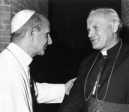
Pope Paul VI greets Karol Cardinal Wojtyla.
|
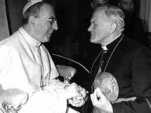
Pope John Paul I greets Karol Cardinal Wojtyla.
|
In 1942 he entered the underground seminary run
by the Archbishop of Kraków, Cardinal Sapieha.
Karol Wojtyla was ordained a priest on 1 November 1946.
On 4 July 1958 Pope Pius XII named him titular bishop
of Ombi and auxiliary to Archbishop Baziak, apostolic
administrator of the Archdiocese of Kraków. Karol
Wojtyla found himself at 38 the youngest bishop in Poland.
In 1962 Bishop Wojtyla took part in the Second Vatican
Council, and in December 1963 Pope Paul VI appointed
him Archbishop of Kraków. Paul VI elevated him
to cardinal in 1967.

A Pope from Poland
In August 1978 following Paul's death, he voted
in the Papal Conclave that elected Pope John Paul I,
who at 65 was considered young by papal standards. However
John Paul I was in poor health and he died after only
33 days as pope, thereby precipitating another conclave.
Voting in the second conclave was divided between two
particularly strong candidates: Giuseppe Cardinal Siri,
the Archbishop of Genoa; and Giovanni Cardinal Benelli,
the Archbishop of Florence and a close associate of
Pope John Paul I. In early ballots, Benelli came within
nine votes of victory. However Wojtyla secured election
as a compromise candidate, in part through the support
of Franz Cardinal König and others who had previously
supported Cardinal Siri.
He became the 264th Pope according to the Vatican (265th
according to sources that count Pope Stephen II). At
only 58 years of age, he was the youngest pope elected
since Pope Pius IX in 1846. Like his immediate predecessor,
Pope John Paul II dispensed with the traditional Papal
coronation and instead received ecclesiastical investiture
with the simplified Papal inauguration.

Assassination attempts
On 13 May 1981 John Paul II was shot and critically
wounded by Mehmet Ali Agca, a Turkish gunman, as he
entered St. Peter's Square to address an audience.
Agca was eventually sentenced to life imprisonment.
Two days after Christmas 1983, John Paul II visited
the prison where his would-be assassin was being held.
The two spoke privately for some time. John Paul II
said, "What we talked about will have to remain
a secret between him and me. I spoke to him as a brother
whom I have pardoned and who has my complete trust."
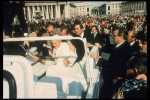
Pope John Paul II after being shot.
Another assassination attempt took place on 12
May 1982 in Fatima, Portugal when a man tried to stab
John Paul II with a bayonet, but was stopped by security
guards.
The assailant, an ultraconservative Spanish priest named
Juan María Fernández y Krohn, reportedly
opposed the reforms of the Second Vatican Council and
called the pope an agent of Moscow. He served a six-year
sentence, and was expelled from Portugal afterwards.

Health of Pope John
Paul II
When he first entered the papacy in 1978, John
Paul II was an avid sportsman, enjoying hiking and swimming.
In addition, John Paul II travelled extensively after
becoming pope; at the time, the 58-year old was extremely
healthy and active.
In 1981, though, John Paul II's health suffered a major
blow after a failed assassination attempt. The bullet-wound
caused severe bleeding, and the Pope's blood pressure
dropped. In addition, a colostomy was also performed.
In the late 1990s, John Paul II began to suffer from
slurred speech and difficulty in hearing. In addition,
the Pope rarely walked in public. Though not officially
confirmed by the Vatican until 2003, most experts agreed
that the frail pontiff suffered from Parkinson's Disease.
In February 2005 John Paul II was taken to the hospital
with an inflammation of the larynx, the result of influenza.
Though later released from the hospital, he was taken
back later that month after difficulty breathing. A
tracheotomy was performed, limiting the pope's speaking
abilities.
In March of 2005, speculation was high that the Pope
was near-death; this was confirmed by the Vatican days
before John Paul II passed away.

Death
On 31 March 2005 the Pope developed a very high
fever, but was neither rushed to the hospital, nor offered
life support, apparently in accordance with his wishes
to die in the Vatican. Later that day Vatican sources
announced that John Paul II had been given the Anointing
of the Sick by his friend and secretary Archbishop Stanislaw
Dziwisz. During the final days of the Pope's life, the
lights were kept burning through the night where he
lay in the Papal apartment on the top floor of the Apostolic
Palace.
Thousands of people rushed to the Vatican, filling St
Peter's Square and beyond, and held vigil for two days.
He died in his private apartments, at 21:37 CEST (19:37
UTC) on 2 April, 46 days short of his 85th birthday.
A crowd of over two million within Vatican City, over
one billion Catholics world-wide, and many non-Catholics
mourned John Paul II. The Poles were particularly devastated
by his death. The public viewing of his body in St.
Peter's Basilica drew over four million people to Vatican
City and was one of the largest pilgrimages in the history
of Christianity. Many world leaders expressed their
condolences and ordered flags in their countries lowered
to half-mast. Numerous countries with a Catholic majority,
and even some with only a small Catholic population,
declared mourning for John Paul II.

Funeral
The death of Pope John Paul II set into motion
rituals and traditions dating back to medieval times.
The Rite of Visitation took place from 4 April through
22:00 CET (20:00 UTC) on 7 April at St. Peter's Basilica.
On 8 April the Mass of Requiem was conducted by the
Dean of the College of Cardinals, Joseph Ratzinger,
who would become the next pope. It has been estimated
to have been the largest attended funeral of all time.
John Paul II was interred in the grottoes under the
basilica, the Tomb of the Popes. He was lowered into
the tomb that had been occupied by the remains of Blessed
Pope John XXIII, but which had been empty since his
remains had been moved into the main body of the basilica
after his beatification by John Paul II in 2003.
Two million people reportedly viewed Pope John Paul
II's body lying in state.

John Paul "The
Great"
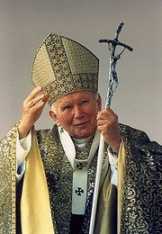
Pope John Paul II
Since the death of John Paul II, a number of clergy
at the Vatican have been referring to the late pontiff
as "John Paul the Great"—only the fourth
pope to be so acclaimed, and the first since the first
millennium. His successor, Pope Benedict XVI, referred
to him as "the great Pope John Paul II" in
his first address from the loggia of St Peter's Church.
The Italian newspaper Corriere della Sera even called
him "the Greatest".
Scholars of canon law say that there is no official
process for declaring a pope "Great"; the
title establishes itself through popular, and continued,
usage. The three popes who today commonly are known
as "Great" are Leo I, who reigned from 440–461
and persuaded Attila the Hun to withdraw from Rome;
Gregory I, 590–604, after whom the Gregorian Chant
is named; and Nicholas I, 858–867, who also withstood
a siege of Rome (in this case from Carolingian Christians,
over a dispute regarding marriage annulment).
Historically, the title "the Great" has been
reserved to the first pope (or sovereign) in a line
bearing a name. John Paul II would, by this criterion,
be unlikely to be dubbed "the Great." Within
a few weeks of the papal funeral, and with the election
of Benedict XVI, popular and media interest in the extention
of this title to John Paul II had all but disappeared.

Beatification
On 13 May 2005 Benedict XVI made his first promulgation
of the beatification process choosing to honour his
predecessor, John Paul II. Normally five years pass
before the beatification process begins for a person
after his or her death but due to the popularity of
John Paul II—devotees chanted "Santo subito!"
("Saint now!") during the late pontiff's funeral—Benedict
XVI waived the custom and officially styled the late
pope with the title given to all those being scrutinized
in the beatification process, Servant of God.
Pope Benedict XVI begins process for sainthood of Pope
John Paul II.
Upon the confirmation after scrutiny that the late pontiff's
life is found morally clean and manifest heroic virtues,
a decree will be proclaimed and John Paul II will be
declared Venerable on the road to beatification. Before
changes in canon law in 1917, the title Venerable was
given at the same time a person was declared Servant
of God. Today, the titles are separate. Upon the confirmation
of miracles attributed to the honoree, John Paul II
would then be declared Blessed. A person is strictly
prohibited from being officially celebrated in Mass
until he or she achieves the title of Blessed.

Life's work - Teachings
of Pope John Paul II
As pope, John Paul II's most important role was
to teach people about Roman Catholic Christianity. He
wrote a number of important documents that many observers
believe will have long-lasting influence on the Church.
A notable achievement of John Paul II was the publication
of the Catechism of the Catholic Church, which became
an international bestseller. Its purpose, according
to the Pope's Apostolic Constitution Fidei Depositum
was to be "a statement of the Church's faith and
of Catholic doctrine, attested to or illumined by Sacred
Scripture, the Apostolic Tradition and the Church's
Magisterium." His first encyclical letters focused
on the Triune God; the very first was on Jesus the Redeemer
("Redemptor Hominis").

Coat of Arms of Pope John Paul II
The letter M is for Mary, Jesus' mother.
In his Apostolic Letter At the beginning of the
third millennium (Novo Millennio Ineunte), a "
program for all times" he emphasized the importance
of "starting afresh from Christ": "No,
we shall not be saved by a formula but by a Person."
In The Splendor of the Truth (Veritatis Splendor) he
emphasized the dependence of man on God and his law
("Without the Creator, the creature disappears")
and the "dependence of freedom on the truth".
He warned that man "giving himself over to relativism
and skepticism, goes off in search of an illusory freedom
apart from truth itself".
John Paul II also wrote extensively about workers and
the social doctrine of the Church, which he discussed
in three encyclicals. Through his encyclicals, John
Paul also talked about the dignity of women and the
importance of the family for the future of mankind.
Other important documents include The Gospel of Life
(Evangelium Vitae), Faith and Reason (Fides et Ratio),
and Orientale Lumen (Light of the East).
John Paul II was also considered by some to have halted
the progressive efforts of Vatican II, becoming a standard-bearer
for the conservative side of the Catholic Church. He
continued his staunch opposition to contraceptive methods,
abortion and homosexuality.
John Paul II, as a writer of philosophical and theological
thought, was characterised by his explorations in phenomenology.
He is also known for his development of the theology
of the body.

Pastoral trips of Pope
John Paul II
During his pontificate, Pope John Paul II made
over 100 foreign trips, more than all previous popes
put together. In total he logged more than 1.1 million
km (725,000 miles). He consistently attracted large
crowds on his travels, some amongst the largest ever
assembled in human history. While some of his trips
(such as to the United States and the Holy Land) were
to places previously visited by Pope Paul VI (the first
pope to travel widely), many others were to places that
no pope had ever visited before. All these travels were
paid by the money of the countries he visited and not
by the Vatican.
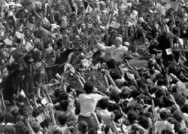
Millions cheer Pope John Paul II during his first
visit to Poland as pontiff in 1979
One of John Paul II's earliest official visits
was to Poland, in June 1979. In 1982 he became the first
reigning pope to travel to the United Kingdom, where
he met Queen Elizabeth II, the Supreme Governor of the
Church of England.
Throughout his trips, he stressed his devotion to the
Blessed Virgin Mary through visits to various shrines
to the Virgin Mary, notably Knock in Ireland, Fátima
in Portugal, Guadalupe in Mexico and Lourdes in France.
In 1984 John Paul II became the first Pope to visit
Puerto Rico.
On 15 January 1995 he offered mass to an estimated crowd
of 4.5 million in Luneta Park, Manila, Philippines,
the largest papal crowd ever. On 22 March 1998 he paid
a second visit to Nigeria. Also in 1999 John Paul II
made another of his multiple trips to the United States.
In 2000 he became the first modern Catholic pope to
visit Egypt, where he met with the Coptic pope and the
Greek Orthodox Patriarch of Alexandria. In May 2001
the Pontiff took a pilgrimage that would trace the steps
of his co-namesake, Saint Paul, across the Mediterranean,
from Greece to Syria to Malta.
He was the first Roman Catholic Pope to visit and pray
in an Islamic mosque, in Damascus, Syria. He visited
Umayyad Mosque, where John the Baptist is believed to
be interred.
In September 2001 amid post-September 11 concerns, he
traveled to Kazakhstan, with an audience of largely
Muslims, as well as Armenia, to participate in the celebration
of the 1700 years of Christianity in that nation.

Relations with other
religions
Pope John Paul II traveled extensively and came
into contact with many divergent faiths. With these
he ceaselessly attempted to find common ground, whether
it be doctrinal or dogmatic. He made history with his
establishment of contacts with Israel, Pope John Paul
II traveled extensively and came into contact with many
divergent faiths. With these he ceaselessly attempted
to find common ground, whether it be doctrinal or dogmatic.
He made history with his establishment of contacts with
Israel, praying at the Western Wall in Jerusalem. Tenzin
Gyatso, the 14th Dalai Lama and the spiritual leader
of Tibetan Buddhism, visited Pope John Paul II eight
times, more than any other single dignitary. The Pope
and the Dalai Lama often shared similar views and understood
similar plights, both coming from peoples who have suffered
under communism.
In contrast, the Northern Irish Protestant leader Ian
Paisley repeatedly accused John Paul II of being the
Antichrist.
|

This picture, often mistakenly regarded as showing
the late Pontiff kissing the Qur'an, in fact shows John
Paul II reverencing a Book of the Gospels.
|

John Paul II meets Tenzin Gyatso, 14th Dalai Lama
at the Vatican in 1999.
|
|
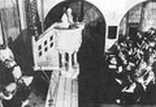
Pope John Paul II becomes the first pope ever to
preach in a Lutheran church; Rome, December 1983
|
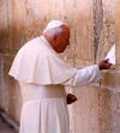
John Paul II prays and expresses sorrow for past
Catholic mistreatment of Jews at the Western Wall
|
|
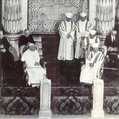
Pope John Paul II visiting The Great Synagogue of
Rome in April 1986
|

Pope John Paul II and Archbishop Christodoulos issue
a "common declaration".
|

Relations with the
Jewish people
Relations between Catholicism and Judaism improved
during the pontificate of John Paul II. He spoke frequently
about the Church's relationship with Jews. In 1979 he
became the first Pope to visit Auschwitz concentration
camp in Poland, where many of his countrymen (mostly
Polish Jews) had perished under Nazi rule. Shortly afterward,
he became the first modern Pope to visit a synagogue
when he visited the Synagogue of Rome on 13 April 1986.
In March 2000, John Paul II visited Yad Vashem, (the
Israeli national Holocaust memorial) in Israel and later
touched the holiest site in Judaism, the Western Wall
in Jerusalem. In October 2003 the Anti-Defamation League
(ADL) issued a statement congratulating John Paul II
on entering the 25th year of his papacy.
Immediately after the pope's death, the ADL issued a
statement that Pope John Paul II had revolutionized
Catholic-Jewish relations, saying that "more change
for the better took place in his 27 year Papacy than
in the nearly 2,000 years before." (Pope John Paul
II: An Appreciation: A Visionary Remembered).
A number of points of dispute still exist between the
Catholic Church and the Jewish community, including
World War II-related issues and issues of doctrine.
Nonetheless, the number of issues that divide Jewish
groups and the Vatican has dropped significantly during
the last 40 years.

Pope John Paul II's
relations with the Eastern Orthodox Church
In May 1999, John Paul II visited Romania on the
invitation from Patriarch Teoctist of the Romanian Orthodox
Church. This was the first time a pope had visited a
predominantly Eastern Orthodox country since the Great
Schism in 1054. On his arrival, the Patriarch and the
President of Romania, Emil Constantinescu, greeted the
Pope. The Patriarch stated, "The second millennium
of Christian history began with a painful wounding of
the unity of the Church; the end of this millennium
has seen a real commitment to restoring Christian unity."
John Paul II visited other heavily Orthodox areas such
as Ukraine, despite lack of welcome at times, and he
said that an end to the Schism was one of his fondest
wishes.
Pope John Paul II could not escape the controversy of
the involvement of Croatian Catholic clergy with the
Ustasa regime of World War II in his relations with
the Serb Orthodox Church. He beatified Aloysius Stepinac
in 1998, the Croatian war-time Archbishop of Zagreb,
a move seen negatively by those who believe that he
was an active collaborator with the Ustaše fascist
regime. On 22 June 2003 he visited Banja Luka in Bosnia
and Herzegovina.
The Pope had been also saying during his entire pontificate
that one of his greatest dreams was to visit Russia,
but this never occurred. He had made several attempts
to solve the problems which arose over a period of centuries
between the Roman Catholic and Russian Orthodox churches,
like giving back the Kazan Icon of the Mother of God
in August 2004. However, the Orthodox side was not that
enthusiastic, making statements like: "The question
of the visit of the Pope in Russia is not connected
by the journalists with the problems between the Churches,
which are now unreal to solve, but with giving back
one of many sacred things, which were illegally stolen
from Russia." (Vsevolod Chaplin).

The Pope for youth
|
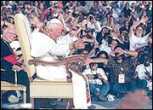
Pope John Paul II met a quarter of a million young
people in Toronto in 2002.
|
Pope John Paul II met a quarter of a million young
people in Toronto in 2002John Paul II had a special
relationship also with Catholic youth and is known by
some as The Pope for Youth. He was a hero to many of
them.
He established World Youth Day in 1984 with the intention
of bringing young Catholics from all parts of the world
together to celebrate their faith. These weeklong meetings
of youth occur every two or three years, attracting
hundreds of thousands of young people, who go there
to sing, party, have a good time and deepen their faith.
His most faithful youths gathered themselves in two
organizations: "papaboys" and "papagirls."

Apologies
Over the later parts of his reign, John Paul II
made several apologies to various peoples that had been
wronged by the Catholic Church through the years. He
publicly made apologies for over 100 of these mistakes,
including:
The persecution of the Italian scientist and philosopher
Galileo Galilei in the trial by the Roman Catholic Church
in 1633 (31 October 1992).
Catholic involvement with the African slave trade (9
August 1993).
The Church's role in burnings at the stake and the religious
wars that followed the Protestant Reformation (May 1995,
in the Czech Republic).
The injustices committed against women in the name of
Christ, the violation of women's rights and for the
historical denigration of women (10 July 1995, in a
letter to "every woman").
Inactivity and silence of Roman Catholics during the
Holocaust (16 March 1998).
For the execution of Jan Hus in 1415 (18 December 1999).
For the sins of Catholics throughout the ages for violating
"the rights of ethnic groups and peoples, and [for
showing] contempt for their cultures and religious traditions".
(12 March 2000, during a public Mass of Pardons).
For the sins of the Crusader attack on Constantinople
in 1204. (4 May 2001, to the Patriarch of Constantinople).
For missionary abuses in the past against indigenous
peoples of the South Pacific (22 November 2001, via
the Internet).
For the massacre of Aztecs and other Mesoamericans by
the Spanish in the name of the Church.

Social and political
stances
|
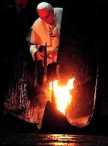
John Paul at the
Holocaust memorial of Yad Vashem.
|
|
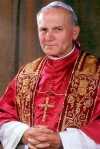
Pope John Paul II
|
John Paul II was a conservative on doctrine and
issues relating to reproduction and the ordination of
women.
A series of 129 lectures given by John Paul during his
Wednesday audiences in Rome between September 1979 and
November 1984 were later compiled and published as a
single work entitled "Theology of the Body,"
an extended meditation on the nature of human sexuality
and masculinity in human life. He also extended it to
condemnation of abortion, euthanasia and virtually all
uses of capital punishment, calling them all a part
of the "culture of death" that is pervasive
in the modern world. His stands on warfare, capital
punishment, world debt forgiveness, and poverty issues
were considered politically liberal, showing that "conservative"
and "liberal" political labels are not easily
assigned to religious leaders.
|

Lech Walesa, leader of Solidarnosc,
received by Pope John Paul II in the
Vatican in January 1981.
|
The pope, who began his papacy when the Soviets
controlled his native country of Poland, as well as
the rest of Eastern Europe, was a harsh critic of communism
and offered support to those fighting for change, like
the Polish Solidarity movement. Soviet leader Mikhail
Gorbachev once said the collapse of the Iron Curtain
would have been impossible without John Paul II.
This view is shared by many people of the post-Soviet
states, who view him, as well as Ronald Reagan, as the
heroes responsible for bringing an end to the communist
tyranny. In later years, John Paul II also criticized
some of the more extreme versions of corporate capitalism.
In 2000 he publicly endorsed the Jubilee 2000 campaign
on African debt relief fronted by Irish rock stars Bob
Geldof and Bono. It was reported that during this period,
U2's recording sessions were repeatedly interrupted
by phone calls from the pope, wanting to discuss the
campaign with Bono.
In 2003 John Paul II also became a prominent critic
of the 2003 US-led invasion of Iraq. He sent former
Apostolic Pro-Nuncio to the United States Pío
Cardinal Laghi to talk with American President George
W. Bush to express opposition to the war. John Paul
II said that it was up to the United Nations to solve
the international conflict through diplomacy and that
a unilateral aggression is a crime against peace and
a violation of international law.
In European Union negotiations for a new European Constitution
in 2003 and 2004, the Vatican's representatives failed
to secure any mention of Europe's "Christian
heritage"—one
of the pope's cherished goals.
The pope was also a leading critic of same-sex marriage.
In his last book, Memory and Identity, he referred to
the "pressures" on the European Parliament
to permit same-sex marriage. Reuters quotes the pope
as writing, "It is legitimate and necessary to
ask oneself if this is not perhaps part of a new ideology
of evil, perhaps more insidious and hidden, which attempts
to pit human rights against the family and against man."
The Pope also criticized transsexual and transgender
people, as the Congregation for the Doctrine of the
Faith, which he supervised, banned them from serving
in church positions, as well as considering them to
have "mental pathologies".

Criticism of Pope John
Paul II
|

Pope John Paul II with Chilean military President
Augusto Pinochet.
|
One charge sometimes leveled at John Paul II was
that his opposition of Communism led him to support
anti-Marxist right-wing dictators. John Paul II occasionally
met with dictators such as Augusto Pinochet of Chile.
John Paul II invited Pinochet to restore democracy,
but, critics claim, not in as firm terms as the ones
he used against communist countries. When the Cold War
ended some conservatives in turn argued that the Pope
moved too far left on foreign policy, and had pacifist
views that were too extreme. His opposition to the 2003
Iraq War was criticized for this reason.
John Paul II was also criticized for his support of
the Opus Dei prelature and the canonization of its founder,
Josemaría Escrivá, whose opponents call
him an admirer of Spanish dictator Francisco Franco.
John Paul II's beliefs about gender roles and sexuality
also came under attack. Some feminists criticized his
positions on the role of women, and gay-rights activists
disagreed with criticism of homosexuality and same-sex
marriage.
His opposition to artificial contraception was particularly
controversial. Claims were made that John Paul II's
papacy spread an unproven belief that condoms do not
block the spread of HIV; between these two claims, many
critics have blamed him for contributing to AIDS epidemics
in Africa and elsewhere in which millions have died.
His supporters disagree and stress the importance of
sexual abstinence in preventing the spread of AIDS.
Critics have also claimed that the large families caused
by lack of contraception have exacerbated Third World
poverty and problems such as street children in South
America.
John Paul II was also criticized for the way he administered
the Church; in particular, critics charged that he failed
to respond quickly enough to the Roman Catholic Church
sex abuse scandal. He was also criticized for recentralizing
power back to the Vatican following the earlier decentralization
of Pope John XXIII. As such he was regarded by some
as a strict authoritarian.
Besides all the criticism from those demanding modernization,
Traditional Catholics were at times equally vehement
in denouncing him from the right, demanding a return
to the Tridentine Mass and repudiation of the reforms
instituted after the Second Vatican Council, such as
the use of the venacular language in Mass.

Other
|

Pope John Paul II appears on the Vatican's €1
coin.
|
John Paul II's apostolic motto was Totus Tuus
("all yours"); he borrowed the motto from
the Marian consecrating prayer of Saint Louis Marie
Grignion de Montfort.
According to a New York Post article of 19 February
2002, John Paul II personally performed three exorcisms
during his tenure as pope.
The first exorcism was performed on a woman in 1982.
His second was in September 2000 when he performed the
rite on a nineteen-year-old woman who had become enraged
in St Peter's Square.
A year later, in September 2001, he performed an exorcism
on a twenty-year-old woman.
The John Paul II International Airport (IATA: KRK),
in Balice, Poland, near Kraków where he served
as Archbishop before being elected Pope, was named in
his honour.
In 2004 he received an extraordinary Charlemagne Award
of the city of Aachen, Germany.
The Harlem Globetrotters visited Pope John Paul II at
the Vatican in November of 2000 and named the Pontiff
an Honorary Harlem Globetrotter.
On 23 March 1999, John Paul II released his debut CD
"Abbà Pater".
John Paul II has been featured on at least seven popular
albums in his native Poland. Most notably singer/songwriter
Stanislaw Sojka’s 2003 album, “Jan Pawel II
-- Tryptyk Rzymski”, a ten-track collection of
the Pope's poems set to music, reached No. 1.
In 2003, his death was incorrectly announced by CNN
when his pre-written obituary (along with those of several
other famous figures) was inadvertently published on
CNN's web site due to a lapse in password protection.

Books by John Paul
II
In chronological order:
Meditations and philosophy
- Memory and Identity - Conversations at the Dawn
of a Millennium, published by Rizzoli (22 March 2005)
ISBN 0847827615 - conversational presentation of John
Paul II's views on many secular topics, such as evil,
freedom, contemporary Europe, nationalism, and democracy.
Included in the book is also a transcript of the Pope's
discussion on his assassination attempt in 1981.
- Rise, Let Us Be On Our Way, Warner Books (28 September
2004),ISBN 0446577812 - mostly addressed to his bishops,
however a rich source of inspiration for everyone having
knowledge of Christianity.
- Pope John Paul II - In My Own Words, Gramercy (6
August 2002) ISBN 0517220849 - best-seller, a compilation
book of carefully selected words and prayers of John
Paul II, compiled by Anthony F. Chiffolo.
- Gift and Mystery - On the Fiftieth Anniversary of
My Priestly Ordination, Image (20 April 1999) ISBN 0385493711
- about being a priest.
- Crossing the Threshold of Hope, Knopf (19 September
1995), ISBN 0679765611 - edited by Vittorio Messori.
John Paul II makes many of his teachings and ideas more
accessible.
- The Way to Christ - Spiritual Exercises, HarperSanFrancisco
(7 October 1994) ISBN 0060642165 - conversational presentation
of two retreats Karol Woytla gave 10 years apart before
becoming pope. In that time he served in Kraków
as bishop and cardinal. A direct and touching book.
- Person and Act, by Karol Wojtyla; before his papacy,
(28 February 1979) ISBN 9027709858. In depth phenomenological
work tied to Thomistic Ethics, apparently there is a
bad translation entitled "the Acting Person".
- Love and Responsibility, by Karol Woytla before
his papacy, Ignatius Press; Rev. edition (1 April 1993)
ISBN 0898704456 - in depth philosophical analysis of
human love and sexuality.
Plays by John Paul II
- Our God's Brother, Ave Maria Press (September 1995)
ISBN 0877938709 - this play was written by Karol Wojtyla
in Poland during World War II when the Nazis were suppressing
Polish arts (1944).
- The Jeweller's Shop: A Meditation on the Sacrament
of Matrimony, Passing on Occasion into a Drama, Arrow,
(17 March 1980) ISBN 009140861X.
- Both of these plays were filmed:
- Our God's brother (in Polish: Brat naszego Boga),
123 min, 1997, colour, directed by Krzysztof Zanussi.
IMDb entry.
- La Bottega dell'orefice (English: The Jeweller's
Shop), 88 min (Canada)/95 min (USA), 1988, colour, directed
by Michael Joseph Anderson. IMDb entry.
Poetry by John Paul II
- The Poetry of Pope John Paul II, USCCB (1 September
2003) ISBN 1574555561 - poems written in the summer
of 2002.
- The Place Within: The Poetry of Pope John Paul II,
Random House; 1st edition (25 October 1994) ISBN 0679760644
- lyrical poetry
Biographies of Pope John Paul II
- Witness to Hope, George Weigel, HarperCollins (1999,
2001) ISBN 006018793X.
- Man of the Century: The Life and Times of Pope John
Paul II, Jonathan Kwitny, Henry Holt and Company, 1997.
- His Holiness: John Paul II and the History of Our
Time, Carl Bernstein and Marco Politi, Doubleday, 1996.
- Pope John Paul II: The Biography, Tad Szulc, Scribner,
1995.
Films about Pope John Paul II
- Pope John Paul II: The Movie, directed by Herbert
Wise, starring Albert Finney, Nigel Hawthorne, Alfred
Burke, John McEnery, Patrick Stewart.
- Pope John Paul's Third Pilgrimage to His Homeland,
a documentary on John Paul's June 1987 visit to Poland.
- From a Far Country (1981), directed by Krzysztof
Zanussi.
- The Millennial Pope: John Paul II (1999) (TV), a
documentary directed by Helen Whitney.
- Storia di Carlo, polish title: Karol. Czlowiek,
który zostal papiezem, 2005, a documentary, directed
by Giacomo Batiatto, based upon a book by Gian Franco
Svidercoschi.
Some other works by or about Pope John Paul II
- List of Encyclicals of Pope John Paul II
- List of pastoral visits of Pope John Paul II outside
Italy
- List of Roman Catholic bishops of Kraków
- Papal election, 2005
- Papabili
- Personalism
- Popemobile
- Sedevacantist antipopes
- The Incredible Popeman
External links

This page was retrieved and condensed from
(http://en.wikipedia.org/wiki/Pope_John_Paul_II) in July, 2005
All text is available under the terms of the GNU Free
Documentation License.

Hui Chin and I were in Poland the day
after Pope John Paul II died.
Here are some of my photos showing
the great adoration and loss the Polish people felt
about their 'Papa'.
You can click on
these photos for an enlargement
 |
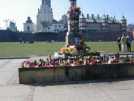 |
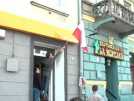 |
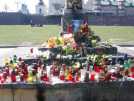 |
| Czestochowa |
Czestochowa |
Czestochowa |
Czestochowa |
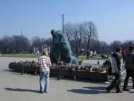 |
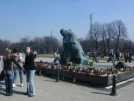 |
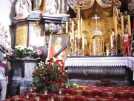 |
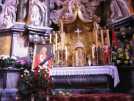 |
| Czestochowa |
Czestochowa |
Czestochowa |
Czestochowa |
 |
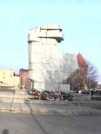 |
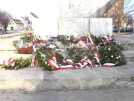 |
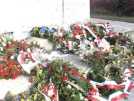 |
| Czestochowa |
Gdansk |
Gdansk |
Gdansk |
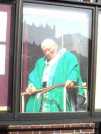 |
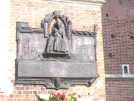 |
 |
 |
| Krakow |
Krakow |
Krakow |
Krakow |
 |
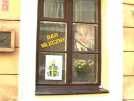 |
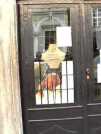 |
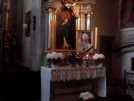 |
| Krakow |
Krakow |
Krakow |
Krakow |
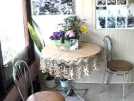 |
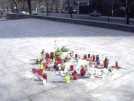 |
 |
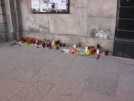 |
| Oswicim
(Austwitz) |
Poznan |
Poznan |
Warsaw |
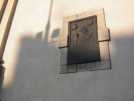 |
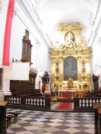 |
 |
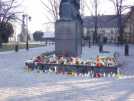 |
| Warsaw |
Warsaw |
Warsaw |
Warsaw |

Site
Index
Back to Top
Photos Index
Thanks for coming, I hope you
have enjoyed it, will recommend
it to your friends, and will come
back later to see my site developing
and expanding.
I'm trying to make my pages
enjoyable and trouble free for everyone,
please let me know of any mistakes
or trouble with links, so I can
fix any problem as soon as possible.
These pages are best viewed with monitor
resolution set at 640x480 and kept simple
on purpose so everyone can enjoy them
across all media and platforms.
Thank you.
You can e-mail me at
Webmaster

|